NCERT Solutions for Class 7 Social Science Geography Chapter 3 Our Changing Earth are part of NCERT Solutions for Class 7 Social Science. Here we have given NCERT Solutions for Class 7 Social Science Geography Chapter 3 Our Changing Earth.
| Board | CBSE |
| Textbook | NCERT |
| Class | Class 7 |
| Subject | Social Science Geography |
| Chapter | Chapter 3 |
| Chapter Name | Our Changing Earth |
| Number of Questions Solved | 8 |
| Category | NCERT Solutions |
Class 7 SST Geography Chapter 3 Our Changing Earth Questions And Answers CBSE
Geography Class 7th Chapter 3 Question Answer
Question 1.
Answer the following questions.
(i) Why do the plates move?
(ii) What are exogenic and endogenic forces?
(iii) What is erosion?
(iv) How are flood plains formed?
(v) What are sand dunes?
(vi) How are beaches formed?
(vii) What are ox-bow lakes?
Answer.
(i) The plates move due to endogenic forces acting in the interior of the earth.
(ii) The forces that act in the interior of the earth are called endogenic forces. The forces that act on the earth’s surface are called exogenic forces.
(iii) Erosion is the wearing away of the landscape by different agents like water, wind, and ice.
(iv) When rivers outflow their banks, they cause floods in the neighbouring areas. The floodwater takes away fine soil and other material and deposits them along the banks. This deposition leads to the formation of flood plains.
(v) Winds lift and carry sand from one place to another. When they stop blowing, sand falls and gets deposited in low hill-like structures called sand dunes.
(vi) Beaches are formed when the sea waves deposit sediments along the shores of the sea.
(vii) When a river enters the plain, it forms a large bend which is cut-off from the mainstream in due course of time. The cut-off stream takes the form of a lake called oxbow lake.
Question 2.
Tick the correct answer.
(i) Which is not an erosional feature of sea waves?
(a) Cliff
(b) Beach
(c) Sea cave
Answer.
(b) Beach.
(ii) The depositional feature of a glacier is:
(a) Flood plain
(b) Beach
(c) Moraine
Answer.
(c) Moraine.
(iii) Which is caused by the sudden movements of the earth?
(a) Volcano
(b) Folding
(c) Flood plain
Answer.
(a) Volcano.
(iv) Mushroom rocks are found in:
(a) Deserts
(b) River valleys
(c) Glaciers
Answer.
(a) Deserts.
(v) Ox-bow lakes are found in:
(a) Glaciers
(b) River valleys
(c) Deserts
Answer.
(b) River valleys.
Question 3.
Match the following.
(i) Glacier (a) Seashore
(ii) Meanders (b) Mushroom rock
(iii) Beach (c) River of ice
(iv) Sand dunes (d) Rivers
(v) Waterfall (e) Vibrations of earth
(vi) Earthquake (f) Seacliff
(g) Hard bedrock
(h) Deserts
Answer.
(i) Glacier (c) River of ice
(ii) Meanders (d) Rivers
(iii) Beach (a) Seashore
(iv) Sand dunes (h) Deserts
(vi) Waterfall (g) Hard bedrock
(vi) Earthquake (e) Vibrations of earth.
Question 4.
Give reasons.
(i) Some rocks have a shape of a mushroom.
(ii) Flood plains are very fertile.
(iii) Sea caves are turned into stacks.
(iv) Buildings collapse due to earthquakes.
Answer.
(i) Because winds erode the lower section of the rock more than the upper part. Therefore, such rocks have a narrower base and wider top.
(ii) Flood plains are formed by the deposition of fine soil and other material called sediments on the river banks. As the soil and sediments are brought by floodwater, they are very fertile.
(iii) After the formation of sea caves when cavities become bigger only the roof of the cave remain, sea arches are formed. Further, erosion breaks the roof and only walls are left. These wall-like features are called stacks.
(iv) In an earthquake, the vibrations travel outwards from the epicenter as waves. The surface starts vibrating which leads to the shaking of structures built on the earth’s surface and thus buildings collapse.
Question 5.
Activity.
Observe the photographs given below. These are various features made by a river. Identify them and also tell whether they are erosional or depositional or landforms formed by both.
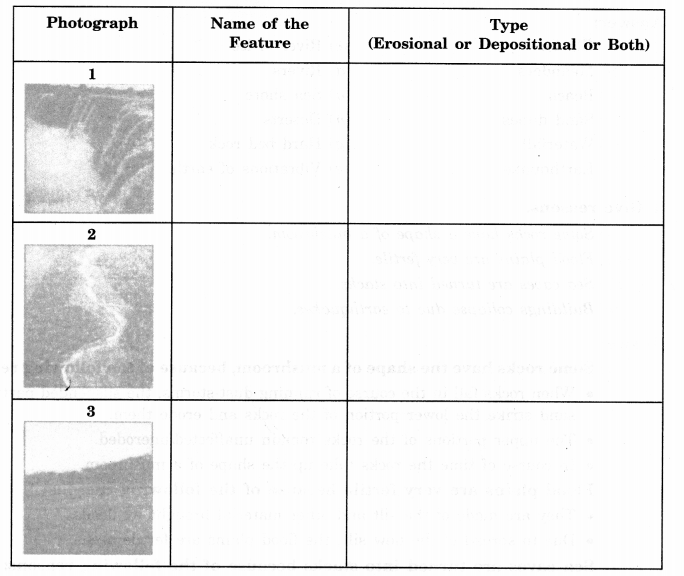
Answer.
| Photograph | Nature of the Feature | Type (Erosional or depositional or Both |
| 1 | Waterfall | Erosional |
| 2 | River valley | Erosional |
| 3 | Flood plain | Depositional |
Question 6.
For fun.
Solve the crossword puzzle with the help of given clues.
Across
2. Loop like the bend of a river.
4. Solid form of water.
7. Moving mass of ice.
9. Sudden descent of water in the bed of a river.
11. Natural cavity on weak rocks formed by the action of waves.
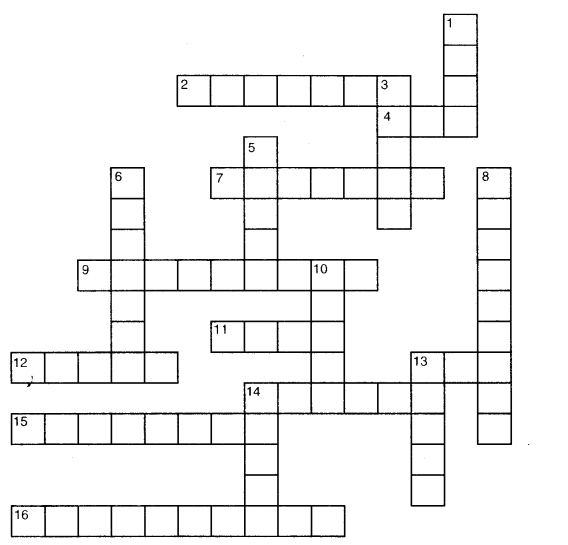
12. Embankment on a river that keeps it in its channel.
13. Large body of seawater.
14. Dry area where sand dunes are found.
15. Small hill of sand caused by the action of the wind.
16. Flat plain formed by river deposits during the time of the flood.
Down
1. Rise and fall of water caused by friction of the wind on the water surface.
3. Flow of water in a channel.
5. Steep perpendicular face of rock along a sea coast.
6. Debris of boulder and coarse material carried by a glacier.
8. Crescent-shaped lake formed by a meandering river.
10. Fine sand deposited by the action of the wind.
13. Isolated mass of rising steep rock near a coastline.
14. Alluvial tracts of land formed by the river deposits at the mouth of a river.
Answer.
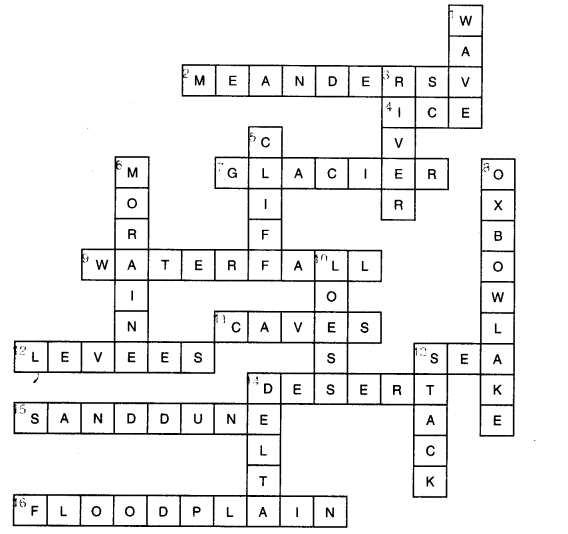
ACTIVITY
Earthquake-A case study
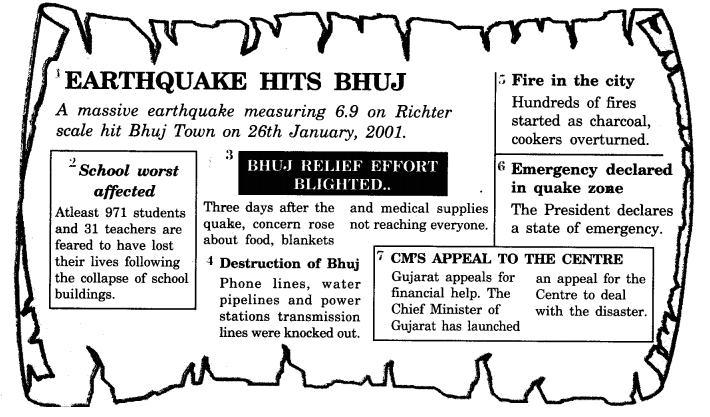
Activity
1. Read the ‘Earthquake – A case study’ given in the form of headlines that appeared in the newspapers after the quake. Arrange the events in the right sequence of their happening.
2. Imagine if a quake suddenly shook in the middle of the school day, where do you go for safety?
Answer.
1. Sequence
![]()
2. We would go for safety
- in the open
- under the gates
- would keep pillow or cushion on our heads.
Class 7 Social Science Geography Chapter 3 Intext Questions With Their Answers
Question 1.
Find out the names of a few rivers of the world that form a delta?
Answer.
Name of some rivers (See the Map):
- Mississippi—Missouri.
- Amazon.
- Parana—Paraguay.
- The Nile.
- Zaire.
- Tigris—Euphrates.
- Ganga—Brahmaputra.
- Indus.
- Hwang Ho.
- Yangtese.
- Irrawaddy.
- Salwin.
- Murray—Darling.
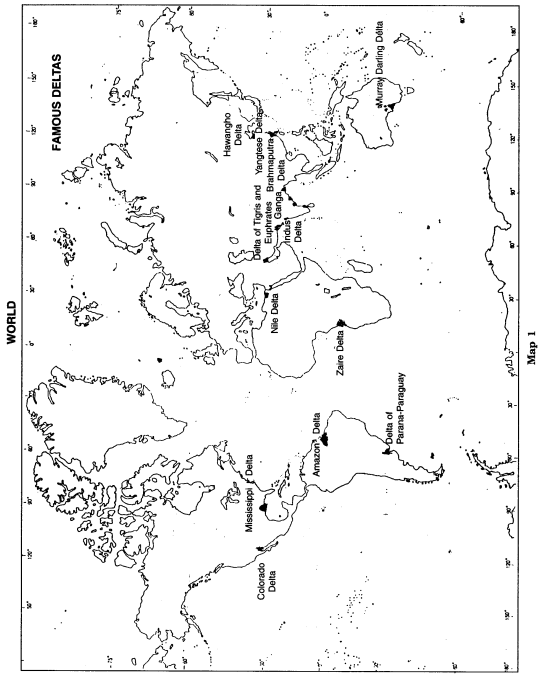
We hope the NCERT Solutions for Class 7 Social Science Geography Chapter 3 Our Changing Earth help you. If you have any query regarding NCERT Solutions for Class 7 Social Science Geography Chapter 3 Our Changing Earth, drop a comment below and we will get back to you at the earliest.
Class 7 Social Science Geography Questions and Answers
- Environment Class 7 Question Answer
- Inside our Earth Class 7 Question Answer
- Our Changing Earth Class 7 Question Answer
- Air Class 7 Question Answer
- Water Class 7 Question Answer
- Natural Vegetation and Wild Life Class 7 Question Answer
- Human Environment: Settlement, Transport and Communication Class 7 Question Answer
- Human Environment Interactions: The Tropical and the Subtropical Region Class 7 Question Answer
- Life in the Temperate Grasslands Class 7 Question Answer
- Life in the Deserts Class 7 Question Answer